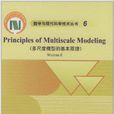《多尺度模型的基本原理(英文版)》系統介紹有關多尺度建模的基本問題,主要介紹其基本原理而非具體套用。前四章介紹有關多尺度建模的一些背景材料,包括基本的物理模型,例如,連續統力學、量子力學,還包括一些多尺度問題中常用的分析工具,例如,平均方法、齊次化方法、重正規化群法、匹配漸近法等,同時,還介紹了運用多尺度思想的經典數值方法。接下來介紹一些更前沿的內容:多物理模型的實例,即明確使用多物理漸近的分析模型,當巨觀經驗模型不足時,藉助微觀模型,使用數值方法來獲取複雜系統的巨觀行為規律,使用數值方法將巨觀模型和微觀模型結合起來,以便更好地解決局部奇點、虧量及其他問題;最後一部分主要介紹三類具體問題:帶多尺度係數的微分方程、慢動力和快動力問題以及其他特殊問題。
基本介紹
- 書名:多尺度模型的基本原理
- 作者:鄂維南
- 出版日期:2012年2月1日
- 語種:英語
- ISBN:9787030334855, 703033485X
- 外文名:Principles of multiscale modeling
- 出版社:科學出版社
- 頁數:397頁
- 開本:16
- 品牌:科學出版社
內容簡介
圖書目錄
Preface
Chapter 1 Introduction
1.1 Examples of multiscale problems
1.1.1 Multiscale data and their representation
1.1.2 Differential equations with multiscale data
1.1.3 Differential equations with small parameters
1.2 Multi-physics problems
1.2.1 Examples of scale-dependent phenomena
1.2.2 Deficiencies of the traditional approaches to modeling
1.2.3 The multi-physics modeling hierarchy
1.3 Analytical methods
1.4 Numerical methods
1.4.1 Linear scaling algorithms
1.4.2 Sublinear scaling algorithms
1.4.3 Type A and type B multiscale problems
1.4.4 Concurrent vs. sequential coupling
1.5 What are the main challenges?
1.6 Notes
Bibliography
Chapter 2 Analytical Methods
2.1 Matched asymptotics
2.1.1 A simple advection-diffusion equation
2.1.2 Boundary layers in incompressibleflows
2.1.3 Structure and dynamics of shocks
2.1.4 Transition layers in the Allen-Cahn equation
2.2 The WKB method
2.3 Averaging methods
2.3.1 Oscillatory problems
2.3.2 Stochastic ordinary differential equations
2.3.3 Stochastic simulation algorithms
2.4 Multiscale expansions
2.4.1 Removing secular terms
2.4.2 Homogenization of elliptic equations
2.4.3 Homogenization of the Hamilton-Jacobi equations
2.4.4 Flow in porous media
2.5 Scaling and self-similar solutions
2.5.1 Dimensional analysis
2.5.2 Self-similar solutions of PDEs
2.6 Renormalization group analysis
2.6.1 The Ising model and critical exponents
2.6.2 An illustration of the renormalization transformation
2.6.3 RG analysis of the two-dimensional Ising model
2.6.4 A PDE example
2.7 The Mori-Zwanzig formalism
2.8 Notes
Bibliography
Chapter 3 Classical Multiscale Algorithms
3.1 Multigrid method
3.2 Fast summation methods
3.2.1 Low rank kernels
3.2.2 Hierarchical algorithms
3.2.3 The fast multi-pole method
3.3 Adaptive mesh refinement
3.3.1 A posteriori error estimates and local error indicators
3.3.2 The moving mesh method
3.4 Domain decomposition methods
3.4.1 Non-overlapping domain decomposition methods
3.4.2 Overlapping domain decomposition methods
3.5 Multiscale representation
3.5.1 Hierarchical bases
3.5.2 Multi-resolution analysis and wavelet bases
3.6 Notes
Bibliography
Chapter 4 The Hierarchy of Physical Models
4.1 Continuum mechanics
4.1.1 Stress and strain in solids
4.1.2 Variational principles in elasticity theory
4.1.3 Conservation laws
4.1.4 Dynamic theory of solids and thermoelasticity
4.1.5 Dynamics of fluids
4.2 Molecular dynamics
4.2.1 Empirical potentials
4.2.2 Equilibrium states and ensembles
4.2.3 The elastic continuum limitthe Cauchy-Born rule
4.2.4 Non-equilibrium theory
4.2.5 Linear response theory and the Green-Kubo formula
4.3 Kinetic theory
4.3.1 The BBGKY hierarchy
4.3.2 The Boltzmann equation
4.3.3 The equilibrium states
4.3.4 Macroscopic conservation laws
4.3.5 The hydrodynamic regime
4.3.6 Other kinetic models
4.4 Electronic structure models
4.4.1 The quantum many-body problem
4.4.2 Hartree and Hartree-Fock approximation
4.4.3 Density functional theory
4.4.4 Tight-binding models
4.5 Notes
Bibliography
Chapter 5 Examples of Multi-physics Models
5.1 Brownian dynamics models of polymer fluids
5.2 Extensions of the Cauchy-Born rule
5.2.1 High order, exponential and local Cauchy-Born rules
5.2.2 An example of a one-dimensional chain
5.2.3 Sheets and nanotubes
5.3 The moving contact line problem
5.3.1 Classical continuum theory
5.3.2 Improved continuum models
5.3.3 Measuring the boundary conditions using molecular dynamics
5.4 Notes
Bibliography
Chapter 6 Capturing the Macroscale Behavior
6.1 Some classical examples
6.1.1 The Car-Parrinello molecular dynamics
6.1.2 The quasi-continuum method
6.1.3 The kinetic scheme
6.1.4 Cloud-resolving convection parametrization
6.2 Multi-grid and the equation-free approach
6.2.1 Extended multi-grid method
6.2.2 The equation-free approach
6.3 The heterogeneous multiscale method
6.3.1 The main components of HMM
6.3.2 Simulating gas dynamics using molecular dynamics
6.3.3 The classical examples from the HMM viewpoint
6.3.4 Modifying traditional algorithms to handle multiscale problems
6.4 Some general remarks
6.4.1 Similarities and differences
6.4.2 Diffculties with the three approaches
6.5 Seamless coupling
6.6 Application to fluids
6.7 Stability, accuracy and effciency
6.7.1 The heterogeneous multiscale method
6.7.2 The boosting algorithm
6.7.3 The equation-free approach
6.8 Notes
Bibliography
Chapter 7 Resolving Local Events or Singularities
7.1 Domain decomposition method
7.1.1 Energy-based formulation
7.1.2 Dynamic atomistic and continuum methods for solids
7.1.3 Coupled atomistic and continuum methods for fluids
7.2 Adaptive model refinement or model reduction
7.2.1 The nonlocal quasicontinuum method
7.2.2 Coupled gas dynamic-kinetic models
7.3 The heterogeneous multiscale method
7.4 Stability issues
7.5 Consistency issues illustrated using QC
7.5.1 The appearance of the ghost force
7.5.2 Removing the ghost force
7.5.3 Truncation error analysis
7.6 Notes
Bibliography
Chapter 8 Elliptic Equations with Multiscale Coeffcients
8.1 Multiscale finite element methods
8.1.1 The generalized finite element method
8.1.2 Residual-free bubbles
8.1.3 Variational multiscale methods
8.1.4 Multiscale basis functions
8.1.5 Relations between the various methods
8.2 Upscaling via successive elimination of small scale components
8.3 Sublinear scaling algorithms
8.3.1 Finite element HMM
8.3.2 The local microscale problem
8.3.3 Error estimates
8.3.4 Information about the gradients
8.4 Notes
Bibliography
Chapter 9 Problems with Multiple Time Scales
9.1 ODEs with disparate time scales
9.1.1 General setup for limit theorems
9.1.2 Implicit methods
9.1.3 Stablized Runge-Kutta methods
9.1.4 HMM
9.2 Application of HMM to stochastic simulation algorithms
9.3 Coarse-grained molecular dynamics
9.4 Notes
Bibliography
Chapter 10 Rare Events
10.1 Theoretical background
10.1.1 Metastable states and reduction to Markov chains
10.1.2 Transition state theory
10.1.3 Large deviation theory
10.1.4 First exit times
10.1.5 Transition path theory
10.2 Numerical algorithms
10.2.1 Finding transition states
10.2.2 Finding the minimal energy path
10.2.3 Finding the transition path ensemble or the transition tubes Transition path sampling
10.3 Accelerated dynamics
10.3.1 TST-based acceleration techniques
10.3.2 Metadynamics
10.4 Notes
Bibliography
Chapter 11 Some Perspectives
11.1 Top-down and bottom-up
11.2 Problems without scale separation
11.2.1 Variational model reduction
11.2.2 Modeling memory effects
Bibliography
《數學與現代科學技術叢書》已出版書目

